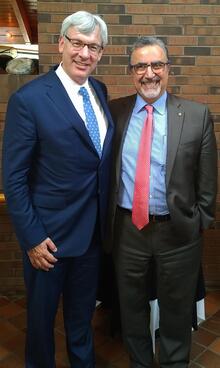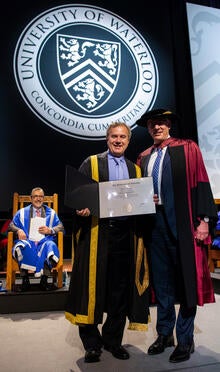
President & CEO of RBC receives Waterloo honorary doctorate
David McKay awarded an honorary Doctor of Mathematics degree.

David McKay awarded an honorary Doctor of Mathematics degree.
By Natalie Quinlan University Relations
David McKay (left) and President Feridun Hamdullahpur (right).
For President and Chief-Executive Officer (CEO) of the Royal Bank of Canada (RBC), Waterloo is a familiar place.
Having graduated with a Bachelor of Math in 1987, David McKay returned during Friday’s convocation to receive an honorary Doctor of Mathematics degree. Addressing a room of more than 700 math graduates, McKay emphasized the importance of always dreaming big, but remaining humble.
“I really do believe that the best advice is to just get on the road, build a series of experiences to draw on, be ambitious with the goals you set, but remain flexible on change,” said McKay. “Focus on skills and experiences rather than careers.”

Tom Jenkins (centre) awarding David McKay (right) with honorary Doctor of Mathematics degree.
Since then, McKay has helped transform the bank’s retail division and introduced new technology that has enabled RBC to adapt and evolve to rapidly changing consumer demands. He champions Canada’s innovation ecosystem and is leading RBC’s support for and partnership with universities, startups and accelerators.
His second piece of advice to new graduates remains as simple as his first—never stop learning.
“I used this approach to accelerate my career at RBC. In addition to my own job, I always made an objective to learn my boss’ job, and to learn one of my peers’ jobs,” said McKay. “Learning three jobs at the same time helps you understand multiple perspectives and helps you support the people around you.”
To learn more about McKay and his journey with the University of Waterloo and RBC, view page eight of this year’s Global Impact Report.

Read more
Meet the 14 exceptional students representing Waterloo’s newest grads

Read more
At the 20th annual awards ceremony, Waterloo announces winners from each of the six faculties for their impactful contributions

Read more
Applying a broad range of tech skills and innovations, Waterloo’s students and alumni are adding value to Shopify’s merchants
The University of Waterloo acknowledges that much of our work takes place on the traditional territory of the Neutral, Anishinaabeg, and Haudenosaunee peoples. Our main campus is situated on the Haldimand Tract, the land granted to the Six Nations that includes six miles on each side of the Grand River. Our active work toward reconciliation takes place across our campuses through research, learning, teaching, and community building, and is co-ordinated within the Office of Indigenous Relations.